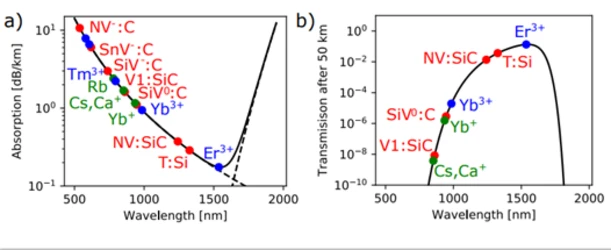To realize long-distance quantum networks, highly efficient and coherent interfaces between photonic and stationary qubits are required at scale. In addition, the wavelength of the photonic qubits plays a critical role.
At microwave frequencies, photonic links at room temperature are impeded by thermal background radiation. Thus, interconnects would require cryogenic cooling, which is impractical on global scales. In contrast, optical photons can be transmitted through standard optical fibers, just like classical information in today’s internet. However, the loss in optical fibers strongly depends on the photon wavelength.
Figure 1a shows the absorption coefficient of optical fibers at the transition frequencies of the most prominent qubit platforms investigated towards quantum networking [1]. Our work is focused on erbium dopants, the only system that exhibits coherent optical transitions in the telecommunications band, where the fiber loss is minimal. As shown in Fig. 1b, at these near-infrared wavelengths, the transmission probability remains above 10% over 50 km distances. This is sufficient for quantum communication using tailored protocols. In comparison, visible light would suffer more than ten orders of magnitude higher loss over the same distance, hindering practical communication rates.

Using erbium not only minimizes photon loss. It also allows our group to use robust photonic components to generate and manipulate optical control fields, which dramatically reduces the experimental overhead. In addition, we can build on the exceptional spin coherence of erbium dopants, which can be on the order of seconds [3]. This exceeds the requirements for long-distance quantum networking as it is much longer than it takes a photon to travel to the other side of the planet. Still, it is not a fundamental limitation, and even longer coherence may be achieved in the future.
The reason why erbium and other rare-earth emitters can exhibit such exceptional coherence is that they can store quantum information in the inner-shell 4f electrons, which are shielded from environmental noise by the outer 5s and 5p electron shells [4]. While this advantage can also be used with ensemble-based approaches to quantum networking [3,5], we focus on individual emitters as they offer additional capabilities - in particular local deterministic quantum gate operations that are favorable for quantum repeater implementations [1].
However, using single erbiuim dopants comes with a key challenge: Their optical transitions are extremely long-lived, with lifetimes of several milliseconds. This would result in rather low fluorescence signals, hindering the detection, coupling, and readout of individual ions. Our group overcomes this challenge by embedding erbium-doped crystals into optical resonators [6] that strongly enhance the interaction of the dopants with electromagnetic fields. This allows our group to implement fast and efficient spin-photon interfaces, which are key enablers for building large-scale quantum networks.
[1] A. Reiserer, Colloquium: Cavity-Enhanced Quantum Network Nodes, Rev. Mod. Phys. 94, 041003 (2022).
[2] B. Merkel et al., Coherent and Purcell-Enhanced Emission from Erbium Dopants in a Cryogenic High-Q Resonator, Phys. Rev. X 10, 041025 (2020).
[3] M. Rančić et al., Coherence Time of over a Second in a Telecom-Compatible Quantum Memory Storage Material, Nature Phys 14, 1 (2018).
[4] C. W. Thiel et al., Rare-Earth-Doped Materials for Applications in Quantum Information Storage and Signal Processing, Journal of Luminescence 131, 353 (2011).
[5] M. Zhong et al., Optically Addressable Nuclear Spins in a Solid with a Six-Hour Coherence Time, Nature 517, 177 (2015).